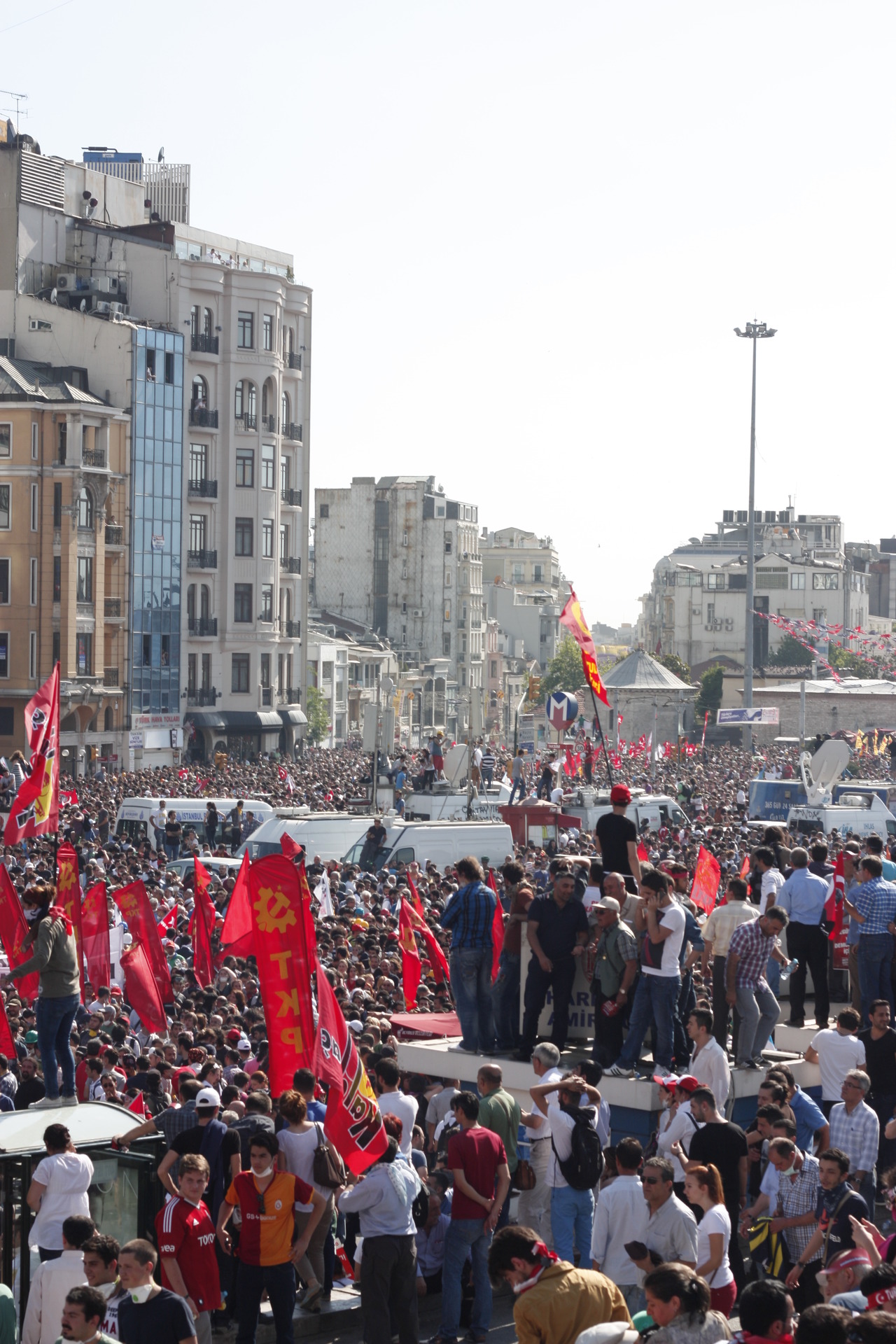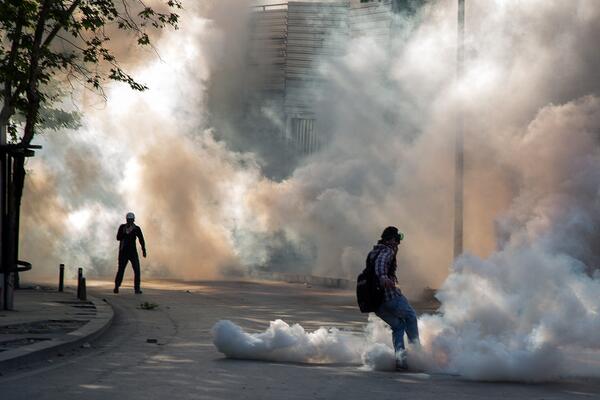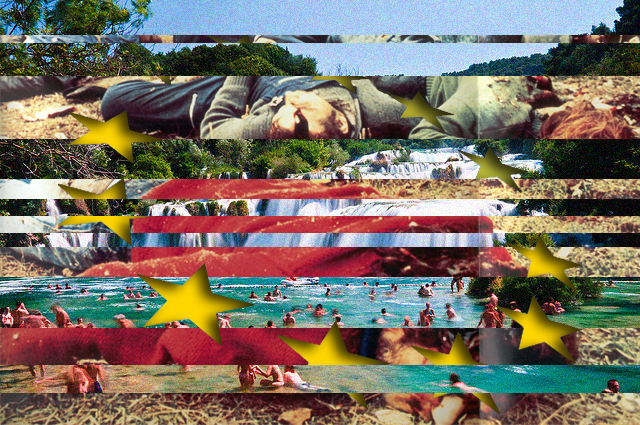
Riots in Istanbul – Part One
Friday 31st May:
My first encounter with the Gezi Park protests was unplanned. I had ventured out of my flat in search of dinner, vaguely aware that there had been a sit-in at Gezi Park, that had been cleared rather violently, that morning. Gezi Park is unremarkable as parks go, except that there are very few left in this rapidly urbanising city of 20 million, and it has been slated for destruction as part of an effort to revamp Taksim Square, the vast transport and commercial hub that constitutes Istanbul’s beating heart, of which Gezi Park is a part.
I found myself at about 8pm on Istiklal Caddesi, the pedestrian road steeped in late-Ottoman grandeur that runs from Taksim Square part of the way to the Golden Horn. The place was agitated, which is not in itself unusual – in addition to being the icon of Turkey’s great capitalist boom (home to flagship stores of both multinational and Turkish chains of all sorts) it is also ground zero for any number of protest marches, which are usually followed by a phalanx of the ubiquitous riot police. At this moment there was no march, however, and the police were absent; more intriguingly there was thick smoke rising from the Taksim end of the road, the direction the crowds were moving. I worked my way up towards Taksim.
Istiklal Caddesi is generally festively decked out, with Christmas-like lights hanging across it and the lively colours that characterise all the great temples of consumption in the world. Today it was strewn with rubbish, and many of the shops along it had been closed and sealed off by their owners. As I worked my way further up through the throng, I found that makeshift barricades had been thrown up, made of overturned municipal flower-pots, mostly, and, of course, piles of rubbish. The crowd was gradually moving forward, although I was moving quicker than most, and I finally stopped about fifty yards behind the farthest barricade, in the middle of my first riot. The crowd at this end was relatively thin, although people were urging forward those further behind. As the crowds at the front thickened, the police opened fire with tear-gas canisters, which momentarily was quite awesome: arcs of thick white mist criss-crossing against the blue sky and old stone buildings. The spell was broken as they came to earth, sliding across the cobblestones and billowing more gas than it would seem possible to stuff into a three-inch cylinder. Suddenly the eyes began to burn – as though one had stared directly at the sun – and the roof of the mouth began to sting; people began to run away, although the more stalwart appealed ‘yavaș yavaș!’ – ‘slowly!’ – in a call for a dignified retreat. After moving out of the immediate range of the canisters, the crowd mostly obliged.
I am no one’s revolutionary. My political beliefs are seldom expressed in mass marches through the great conurbations of the world. Nevertheless, I have no problem with the notion that prime minister Recep Tayyip Erdogan is a bastard. His increasingly authoritarian rule has seen dozens of journalists imprisoned on the very loosely-defined charges for which the Turkish penal code is notorious, and after eleven years in power, his plans to reform the constitution to give himself the central role in a powerful presidential system should, and do, ring alarm bells. In any case I am certainly happy to fight for a park against a shopping mall, and this particular shopping mall especially deserves stopping – it is to be a kitschy faux-Ottoman pile, supposedly a reconstruction of an Ottoman barracks that once stood there, a nasty temple to an empire whose sectarianism, injustice and ignominious (and quite recent) end most Istanbullus would rather not dwell on. In any case, whatever one’s ideology, people deserve a park.
This simple reasoning – people deserve a park – seems to be at the heart of this explosion of dissatisfaction. The right-wing, conservative, mildly Islamist government of Erdogan (‘Tayyip’ as he’s informally known) has never been wildly popular in Istanbul, outside the vast slums that house the millions of rural migrants whose support was probably instrumental in making Erdogan the city’s mayor. The grievances of late include a ban on night-time alcohol sales (which strike at the twin pillars of Istanbul life: copious alcohol consumption and refusal to acknowledge the difference between day and night) and on alcohol sales within 100 meters of a mosque, an area that covers much of the city; recent rows over public kissing also contribute to a feel, among the city’s proudly secular and Westernised residents, that their civil rights are being squeezed by the dour Islamic conservatism of the villages. Beyond this there’s an element of wounded civic pride – to the Istanbullu, the natural order of things is for Istanbul to lie at the apex of the Near East, as it did for nearly two thousand years, before everything fell apart less than a hundred years ago. Now the city is run on the whims of an authoritarian from Ankara and his rural electoral base, whims which have already included the controversial third Bosphorus bridge (construction of which will chew up even more of the city’s diminishing parkland). Turkey has boomed economically – the global recession has barely registered here – but boom has brought vast inequality, and little effort has been made to turn the prosperity into cultural endeavours or even a functioning welfare system. The city is no stranger to protest from all sorts of factions to the government’s left, but with the relatively apolitical nature of the Gezi Park dispute, dissatisfaction found its universal banner. People deserve a park.
Going through a (probably condensed) version of this logic in my head, I had no objection to these protests, but finding myself here I stayed, more for the excitement than anything else. I couldn’t quite bring myself to join in the throwing of torn-out cobblestones or the rallying of crowds, because bound both by foolish bourgeois reluctance and the (even more bourgeois) awareness that my residence papers are not yet fully in order. I mostly stayed along the right-hand side of the canyon-like avenue, occasionally working my way forward to the barricade to peek at the riot police, who with their plastic armour and transparent square shields look like the Roman legions on a narrow budget. The young men and women (and there were quite a few women) holding down the barricades would call the crowd forward, and as they surged, various chants would echo across the avenue. I desperately wished my Turkish were better.
The police were apparently content to hold us at bay with periodic shellings of tear-gas, each time sending us running back several hundred years or ducking into the side-streets, waiting for the gas to clear before the more gung-ho could entice the crowds to reclaim the barricades – ‘gel!’ – for the better part of two hours, until they decided to launch a full-on assault. We were alerted to this with cries of ‘geliyorlar!’ – ‘They’re coming!’ – and indeed, through the thinning gas of the last downpour I could make out the blue-clad legionnaires running tightly in formation, which had something faintly absurd about it – I was reminded of Asterix. But the real spirit of this assault emerged only after they had stopped and begun firing yet more tear-gas at us: two massive, tank-like armoured cars, with steel grills on the front and remotely-controlled water cannons on the roof. The more prudent began to fall back as the tear-gas rained down, I ducking around a corner and caught what glimpses I could from there. Most of the crowd had fallen back, but the truly strong-hearted (who had also remembered gas-masks) held out, waving flags and hurling stones at the oncoming behemoths as the gaseous mist danced around them. The David and Goliath imagery was certainly moving, although I note that if Goliath had been armed with a water-cannon that chapter would have ended somewhat differently, for he may have been a great champion, but unlike the Istanbul police he never had the power to reverse a stone’s direction mid-flight. Water cannons, I also noted, lose their comic aspect in reality, especially as the bastards mixed the water with tear-gas; they simply become a cruel and crude engine of overwhelming force, which is ugly to behold.
The armoured cars advanced, and we fell back still further: I huddled behind a heavily-graffitied cash machine with some Maoists, then fell into the foyer of a ‘han’ or shopping arcade; when the men began trying to close the iron shutters, I ducked out again and made for the next alley. The more courageous, among whose number I decidedly was not, were rushing up the alley with various heavy things that they had grabbed, throwing them onto the barricades, but when the armoured cars came they shoved through the barricades like paper. The two cars advanced inevitably, their path cleared by the endless bombardment of tear-gas canisters (later news reports would allege that some were being launched from helicopters), and there was nothing to do but fall back.
The science of crowd-control is apparently not a matter of reclaiming and holding ground, however, for despite this triumph the police withdrew again to the head of Istiklal Caddesi, and the crowds were again exhorted to return to the barricades. A quarter of an hour later, however, the police launched a second attack. I was at the front line and, eager to take in the situation, fell behind as the crowd fell back. I suddenly found myself in the middle of a wide field of billowing smoke, and intense pain was setting in. A canister hurtled along the cobblestones and came to a halt right at my foot. Those more experienced (and with heavy-duty gloves on) would have picked it up and hurled it back at the oncoming phalanx, but I was already weakened by the gas, so all I did was stumble backwards as, in an instant, the effects set in. I could barely see, and even less think, but I remember that the white gas became as impenetrably thick as a wall.
Tear gas is a brilliant weapon of civic order because its effect on the victim has nothing to do with courage, resolve or strength of character. It is entirely a matter of how much free agency you retain, and in the case of such a direct hit, for the first ninety seconds, there is none at all: the only thing you are physically capable of is running until the air is comparatively clean, then finding a wall, kneeling against it, and retching as if all your body wants is to expel your innards. It’s hell in gaseous form. I crumpled against a wall, lost entirely in the acute agony, and was thankfully yanked into a Starbucks and led up to the second floor, where my face was washed in some milky basic formula that eased the stinging. Already on the recovery, I thanked my benefactor, who disappeared into the swirling crowd, although I overheard, in a concerned tone, the word that Turks append to all that seems to operate according to illogical rules: ‘yabancı’ – ‘foreign’.
I remained in the Starbucks, first in the armchair until I was recovered enough to move to the balcony, whence I could look over the first storey and the chaos outside. The baristas had evidently decided that today, they were with the revolution, and all business was suspended as they rushed water, ice and plates of sliced lemons (good for the tear gas) to the crowds that stumbled in. It was a peculiar cross-section of the tumult, humanity and contradictions of revolt. One student hopped in and, as a fussing crowd assembled around him I saw that his leg had been brutally gashed, presumably by an incoming canister. At one point, a girl yelled up at the balcony to pass onto her comrades the message that ‘the communists are heading out’, which struck me as funny, for some reason. Outside, the cycle of advance and bombardment continued, and I noted the large number of flags that were being carried forward, both the star-and-crescent flag of Turkey, and the banners of the myriad leftist factions. The Turks, as I will go into later, love few things so much as a good symbol.
As my strength returned, I left the Starbucks of the revolution at a suitable ebb in the fighting. I was originally planning on returning home but could not resist remaining in the fray. Again, the police were attempting to reclaim Istiklal Caddesi. We fell back from barrier to barrier as the gas-canisters rained down. I found myself nearer and nearer the front line. The armoured cars had been pulled back – maybe there was some other part of Taksim Square more in need of pulverising – but the police had added flash-bang grenades into the mix, and the loud explosions did more to rattle the crowd than the tear-gas. I once more found myself exposed, this time right in the middle of the street, barely a hundred yards from the police. A flash-bang landed a yard in front of me, ricocheting from the street and slamming into my knee, and then through some improbable miracle of ballistics smashing into my right hand, before going off a foot from my head in a blinding, deafening vortex.
I don’t quite know how I reacted – a sonic boom a foot from one’s head does nothing for one’s spatial awareness – but I was thrown back, stumbling back into the crowd before it occurred to me to take stock of my injuries. Thankfully they were mild almost to insignificance: purple swelling in my index finger and some other scrapes on my hand; my knee was slightly grazed but I could still walk without any problem. I had been unbelievably lucky, considering. In any case, I took this as my cue to leave. On returning to my flat, I did begin to worry slightly about the odd-looking wound on my finger – my instinct was just to bandage it and move on, but this being my first grenade-induced wound, I thought I might err on the side of caution. Going into my local grocery, I asked the men there if they thought I ought to worry, but their advice was precisely my instinct – wrap it in a plaster and leave it to heal.
Some hours laterI decided to return to see what was happening. The crowd had thinned a lot, but there were still enough to hold the barricades, and Istiklal still rang with chants, the rattling of anything metal and the exhortations of ‘gel!’ and ‘yavaș yavaș!’. Indeed, every time those at the front tried to bring forward the masses for a new offensive, they would begin whistling, clapping, chanting and rattling the iron store-shutters. The crowd continued to surge, and to fall back in chaos as the tear gas rolled in. Finally, at around 3am, the police launched the last offensive of the night, pouring in tear gas in quantities thus far unmatched. (Given how much they use the stuff, my guess was that the police were probably wiser than to source their orders of it from Turkish industry. Later, I confirmed this when I picked up an empty canister, and discovered that the manufacturer is someone called ‘Condor’, apparently a Brazilian manufacturer, and their tagline is ‘non-lethal technologies’, which hopefully helps them sleep at night. Later rumours on Twitter alleged that some of the canisters were found to have expired in 2011).
This offensive, perhaps helped by the fact that most of the crowd had since gone home, finally broke the effort to hold Istiklal Caddesi. The demonstrators fell back from this great storm of non-lethal technology, abandoning the avenue and withdrawing into the vast, byzantine (and Byzantine) network of alleys; they continued to march, to chant and whistle and rattle store-shutters, but the inexorable direction was away from Taksim Square. In the night, the police would reclaim Istiklal Caddesi, though the alleys remained outside their realm.
On my way home – by now it was half three – I met my building-manager and several of her business partners, all of whom live in the area. They had set up a table and chairs in a small park across from her office, and in the middle of the night had laid out a meal of nuts, fresh fruit, cheese and rakı, in which they invited me to share. (If there were one moment that embodied the Turkey I’ve come to love in this last year, this might be it). The city was charged with excitement, and everyone around the table were busy discussing the flaws of Tayyip (in expletive-laden terms), ways to get around the block on foreign news sites and the promise of even greater clashes to come.
Follow the events of the riots here: http://occupygezipics.tumblr.com/







